Engine Compartment EVAP Tube Removal Procedure
Important: When replacing the evaporative emission (EVAP) tube, always replace the tube
with original equipment or parts that meet the GM specifications for this part. The
replacement tube must have the same type of fittings as the original tube in order
to ensure the integrity of the connection.
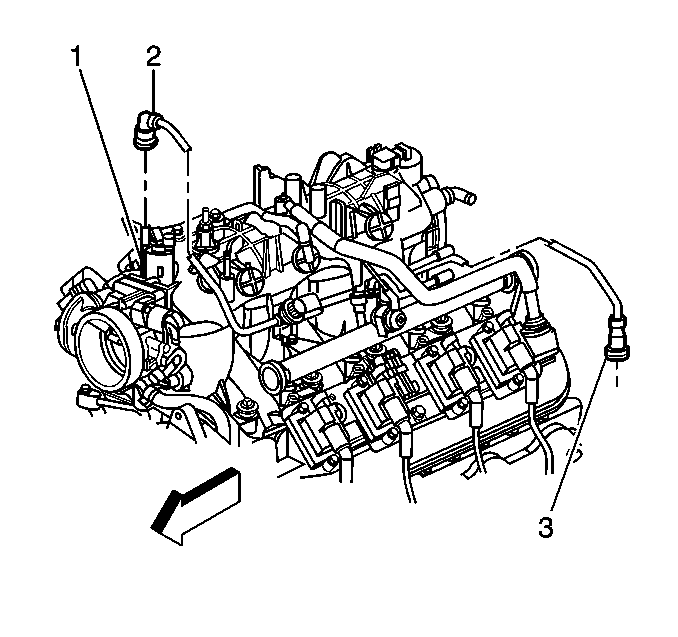
- Remove the engine sight shield. Refer to
Upper Intake Manifold Sight Shield Replacement
in Engine Mechanical-4.8L,
5.3L, and 6.0L.
- Remove the EVAP purge solenoid vent tube by performing the following:
| 2.1. | Push the retainer inward and pull up on the connector. |
| 2.2. | Remove the EVAP tube end (2) from the solenoid (1). |
| 2.3. | Remove the EVAP tube end (3) from the vapor pipe. |
Engine Compartment EVAP Tube Installation Procedure

- Connect the EVAP tube end (3) to the vapor
pipe.
- Connect the EVAP tube end (2) to the solenoid (1).
- Install the engine sight shield. Refer to
Upper Intake Manifold Sight Shield Replacement
in Engine Mechanical-4.8L, 5.3L, and
6.0L.
Chassis EVAP Pipe Removal Procedure
Important: Clean all the fuel pipe connections and the surrounding areas prior to disconnecting
the pipes in order to avoid possible fuel system contamination.
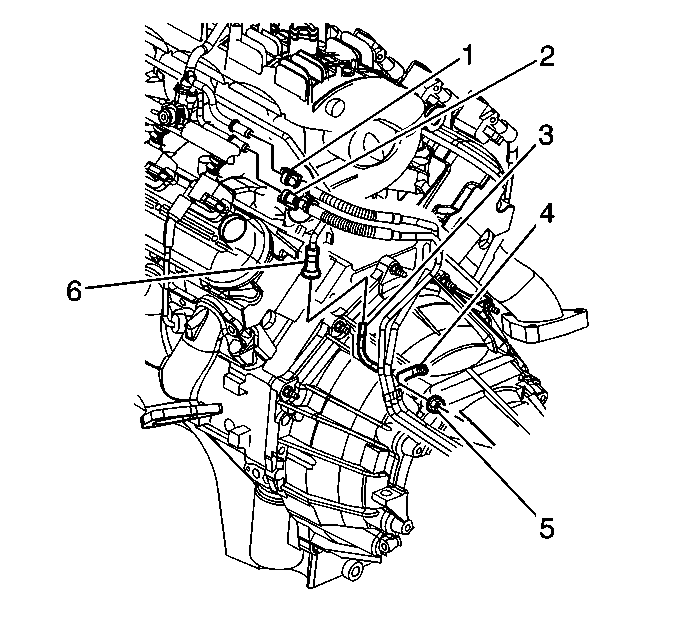
- Relieve the fuel system pressure. Refer
to
Fuel Pressure Relief
.
- Disconnect the fuel feed (1) and return pipes (2) from the fuel rail.
Refer to
Metal Collar Quick Connect Fitting Service
.
- Disconnect the evaporative emission (EVAP) tube rear connection.
- Cap the fuel rail pipes.
- Raise and suitably support the vehicle. Refer to
Lifting and Jacking the Vehicle
in General Information.
- Remove the fuel hose/pipe bracket nut (5) from the bellhousing stud.
- Remove the fuel hose/pipe bracket from the bellhousing stud.
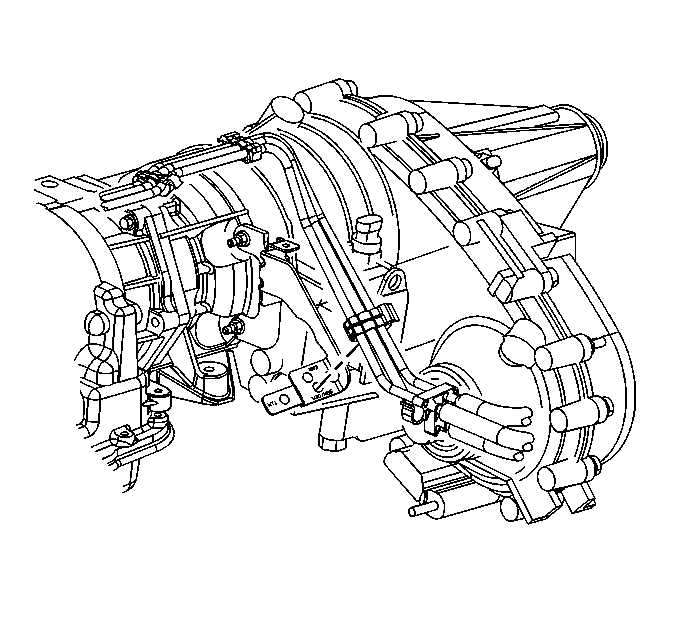
- Remove the fuel hose/pipe clip from the
transfer case bracket, if equipped with four wheel drive (4WD).
- Remove the fuel hose/pipe clips from the transmission brackets.
- Remove the EVAP canister. Refer to
Evaporative Emission Canister Replacement
.
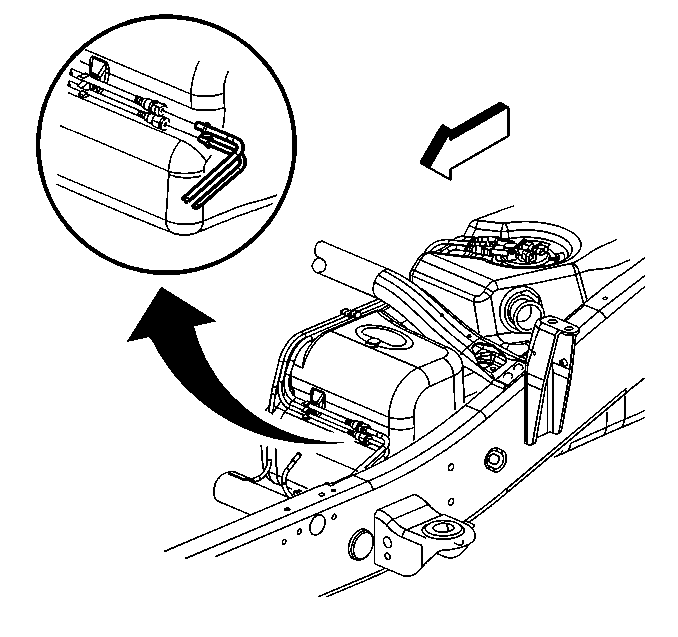
- Disconnect the fuel feed and return hose/pipes
at the fuel tank. Refer to
Plastic Collar Quick Connect Fitting Service
.
- Cap the fuel tank hose/pipes.
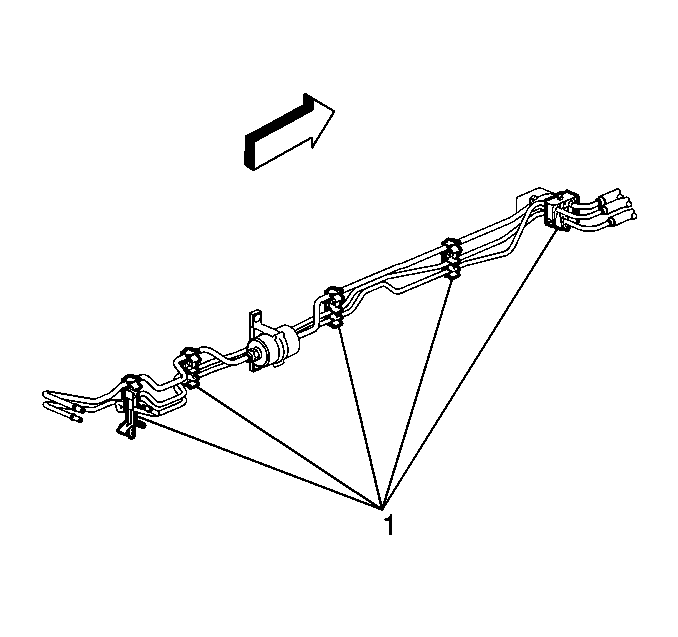
- Remove the fuel hose/pipe retaining clip
(1) nuts.
- Remove the fuel hose/pipe assembly.
Chassis EVAP Pipe Installation Procedure
Important:
| • | When replacing the fuel hose/pipe assembly, always replace them with
original equipment or parts that meet the GM specifications for those parts. The
replacement hose/pipes must have the same type of fittings as the original hose/pipes
in order to ensure the integrity of the connection. |
| • | DO NOT use copper or aluminum tubing to replace steel tubing. Only tubing
meeting the 124-M specification or equivalent is capable of meeting all pressure,
corrosion and vibration characteristics necessary to ensure the durability standard
required. |

- Install the fuel hose/pipe assembly.
- Install the fuel hose/pipe retaining clip (1) nuts.

- Remove the caps from the fuel tank hose/pipes.
- Connect the fuel feed and return hose/pipes at the fuel tank. Refer to
Plastic Collar Quick Connect Fitting Service
.
- Install the EVAP canister. Refer to
Evaporative Emission Canister Replacement
.
- Install the fuel hose/pipe clips to the transmission brackets.

- Install the fuel hose/pipe clip to the
transfer case bracket, if equipped with 4WD.

- Install the fuel hose/pipe bracket to the
bellhousing stud.
- Install the fuel hose/pipe bracket nut (5) to the bellhousing stud.
- Lower the vehicle.
- Remove the caps from the fuel rail pipes.
- Connect the EVAP tube rear connection.
- Connect the fuel feed (1) and return pipes (2) to the fuel rail. Refer
to
Metal Collar Quick Connect Fitting Service
.
- Install the fuel fill cap.
- Connect the negative battery cable. Refer to
Battery Negative Cable Disconnection and Connection
in Engine Electrical.
- Use the following steps in order to inspect for fuel leaks:
| 16.1. | Turn ON the ignition, with the engine OFF, for 2 seconds. |
| 16.2. | Turn OFF the ignition for 10 seconds. |
| 16.3. | Turn ON the ignition, with the engine OFF. |
| 16.4. | Inspect for fuel leaks. |
- Install the engine sight shield. Refer to
Upper Intake Manifold Sight Shield Replacement
in Engine Mechanical-4.8L, 5.3L, and 6.0L.
Rear EVAP Purge Tube Removal Procedure
Important:
| • | When replacing the fuel hose/pipe assembly, always replace them with
original equipment or parts that meet the GM specifications for those parts. The
replacement hose/pipes must have the same type of fittings as the original hose/pipes
in order to ensure the integrity of the connection. |
| • | Clean all the fuel pipe connections and the surrounding areas prior to
disconnecting the pipes in order to avoid possible fuel system contamination. |

- Raise and suitably support the vehicle.
Refer to
Lifting and Jacking the Vehicle
in
General Information.
- Disconnect the rear EVAP purge tube (3) from the EVAP pipe (2).
- Disconnect the rear EVAP purge tube from the EVAP canister (4).
- Remove the rear EVAP purge tube from the clip (1).
- Cap the EVAP pipe and canister in order to prevent possible EVAP system
contamination.
Rear EVAP Purge Tube Installation Procedure

- Remove the caps from the EVAP pipe and
canister.
- Connect the rear EVAP purge tube (3) to the EVAP canister (4).
- Connect the rear EVAP purge tube to the EVAP pipe (2).
- Install the rear EVAP purge tube to the clip (1).
- Lower the vehicle.
EVAP Vent Tube Removal Procedure
Important:
| • | When replacing the fuel hose/pipe assembly, always replace them with
original equipment or parts that meet the GM specifications for those parts. The
replacement hose/pipes must have the same type of fittings as the original hose/pipes
in order to ensure the integrity of the connection. |
| • | Clean all the fuel pipe connections and the surrounding areas prior to
disconnecting the pipes in order to avoid possible fuel system contamination. |
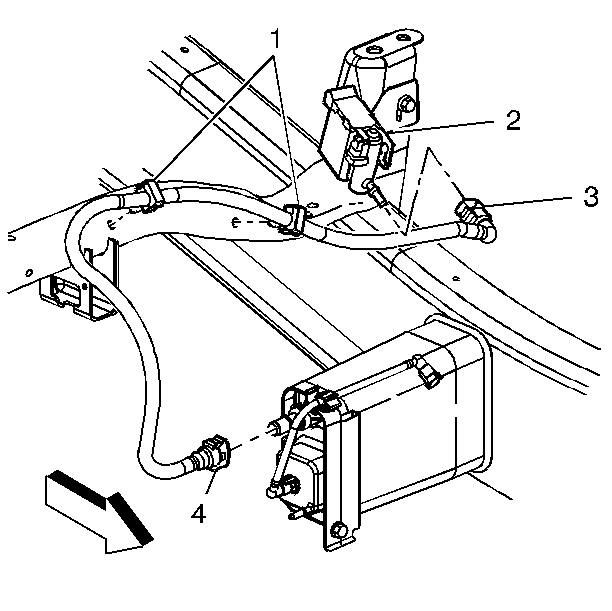
- Remove the fuel tank. Refer to
Fuel Tank Replacement
.
- Disconnect the EVAP vent tube (4) at the EVAP canister.
- Disconnect the EVAP vent tube at the EVAP vent valve (2).
- Remove the EVAP vent tube from the clips (1).
- Cap the EVAP vent valve and canister in order to prevent possible EVAP
system contamination.
EVAP Vent Tube Installation Procedure

- Remove the caps from the EVAP vent valve
and canister.
- Connect the EVAP vent tube to the EVAP vent valve (2).
- Connect the EVAP vent tube (4) to the EVAP canister.
- Install the EVAP vent tube to the clips (1).
- Install the fuel tank. Refer to
Fuel Tank Replacement
.
Rear EVAP Fuel Tank Tube Removal Procedure
Important:
| • | When replacing the fuel hose/pipe assembly, always replace them with
original equipment or parts that meet the GM specifications for those parts. The
replacement hose/pipes must have the same type of fittings as the original hose/pipes
in order to ensure the integrity of the connection. |
| • | Clean all the fuel pipe connections and the surrounding areas prior to
disconnecting the pipes in order to avoid possible fuel system contamination. |
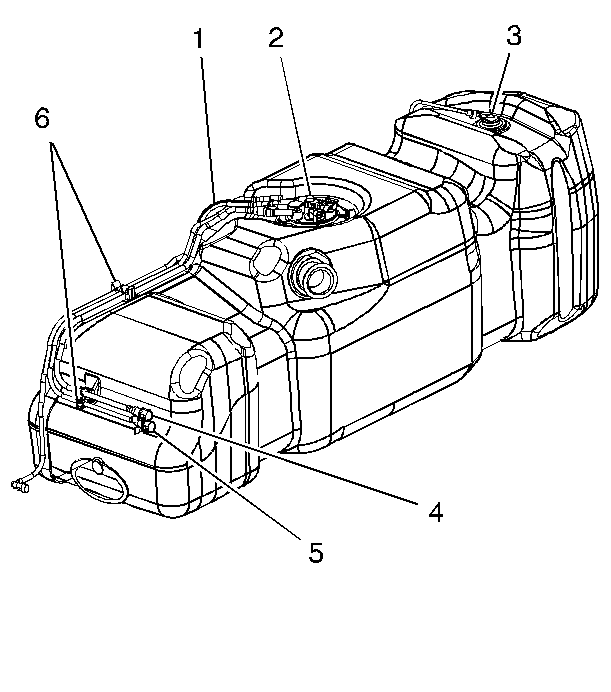
- Remove the fuel tank. Refer to
Fuel Tank Replacement
.
- Disconnect the rear EVAP tube (1) from the fuel sender (2), and roll
over valve (3). Refer to
Plastic Collar Quick Connect Fitting Service
.
- Remove the rear EVAP tube (1) from the fuel tank clips (6).
- Cap the fuel sender and the roll over valve in order to prevent system
contamination.
Rear EVAP Fuel Tank Tube Installation Procedure

- Remove the caps from the fuel sender and
the roll over valve.
- Connect the rear EVAP tube (1) to the fuel sender (2), and roll
over valve (3). Refer to
Plastic Collar Quick Connect Fitting Service
.
- Install the rear EVAP tube (1) to the fuel tank clips (6).
- Install the fuel tank. Refer to
Fuel Tank Replacement
.
















